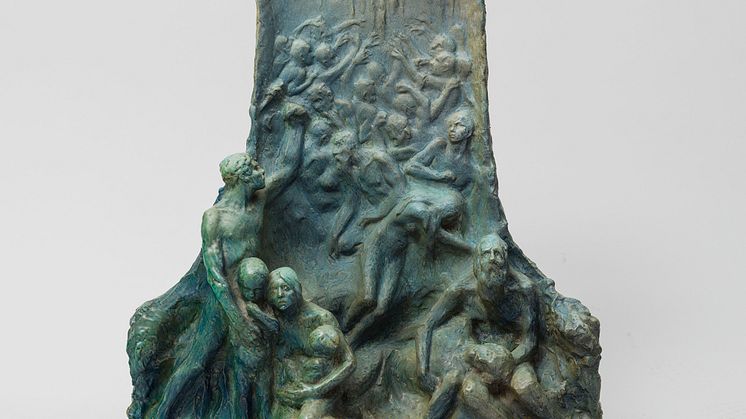
Press release -
New acquisition: The sculpture ”Struggle for existence” by Agnes de Frumerie
Nationalmuseum has acquired a piece created by the Swedish sculptor Agnes de Frumerie (1869-1937) in collaboration with the French ceramist Edmond Lachenal (1855-1948). The sculpture, which is a nearly one meter tall relief made of glazed stoneware, depicts a group of people in an arc shaped opening. According to older sources the title of the piece is “La Source d’Or” and has in Swedish been called “Kampen för tillvaron” (“Struggle for existence”), which appears to allude to a seemingly endless struggle for existence and the pursuit of wealth, where only the strongest survive.
The people portrayed in the foreground of this peace have a resigned appearance and are embracing and supporting each other. In the background one can see clutter of people who are appearing to reach for a rainfall that is falling down from the sky. The signature on the bottom of the sculpture reads “Agnes de Frumerie 1900” and on the back it reads “E. LACHENAL Céramiste á Châtillon Seine 1900”.
Agnes Kjellberg was born in Skövde in 1869. She moved to Stockholm at the young age of 14 in order to study at University College of Arts, Crafts and Design with the ambition of becoming an art teacher. In 1886 she was accepted into Royal Academy of Fine Arts. After several medals and an extended stay in Berlin she was one of the first women to win the large travel scholarship in 1892 and she moved to Paris with her mother. She soon married artillery captain, masseur and subsequent doctor Gustaf Frumerie, and they would remain in Paris for 30 years. In the 1890’s the couple de Frumerie socialized with the Swedish art avant-garde in Paris: Strindberg, the Ericson-Molard couple, Christian Eriksson, to name only a few. In the artistic world Agnes de Frumerie was in the center of the Paris art scene.
During her scholarship years she accounted for everything in letters to the Royal Academy of Fine Arts in Stockholm. Starting in 1893 Frumerie displayed her work at the Salon des Artistes Franҫais and starting in 1895 also at the new salon Salon National des Beaux Arts at the Champs de mars. In 1897-1908 she was also in collaboration with the French ceramist Edmond Lachenal and she displayed her work many times at his exhibitions at Galerie Georges Petit. Agnes de Frumerie was also highly involved in the association of female artists – Union des Femmes Peintres et Sculpteurs – which was formed in 1881, and in 1895 she began to display her work there on a regular basis.
For a long time it was assumed that Agnes de Frumerie studied under Auguste Rodin (1840-1917). This was not the case; instead Frumerie was advised by Rodin to work independently. However, she was one of the Swedish sculptors who were clearly influenced by the French masters. She realized early on how innovative Rodin was and referred to him as a “contemporary Michel-Angelo”. In her statues, de Frumerie resembled Camille Claudel (1864-1943), who even accused de Frumerie of plagiarism.
The influence from Rodin is also clearly visible in this relief. Just like in Rodin’s Gates of Hell, the general composition consists of a mishmash of human bodies in high and low relief. The emphasis is on creating a feeling, which the facial expressions, gestures and looks all contribute to. The ambition that the sculptures had to create monumental pieces surrounding large, universal subjects was in keeping with the spirit of those times.
Also typical for the times was the experimentation with different techniques in arts and crafts. Edmond Lachenal developed the technique with glazed stoneware in different colours, “email mat velouté” (eng: mat velvet opaque glaze) in the 1890’s and he collaborated with different sculptors, of whom Agnes de Frumerie was one of the most significant. This piece by Frumerie and Lachenal was displayed at the Exposition de l’Union des femmes peintres et sculpteurs and at the Galerie Georges Petit in 1900. The model of the sculpture can be found at Västergötland’s museum in Skara.
The acquisitions have been possible through a generous contribution from the Hedda and N.D. Qvist’s Memorial Fund. Nationalmuseum has no government funding to acquire handicraft and art; instead the collections are enriched through gifts and private foundations and funds.
Inventory number: NMSk 2362
More information
Linda Hinners, curator, linda.hinners@nationalmuseum.se, 08-519 544 04
Mattias Robertson, press officer, mattias.robertson@nationalmuseum.se, 0767-23 46 32
Related links
Categories
Nationalmuseum is Sweden’s museum of art and design. The collections comprise older paintings, sculpture, drawings and graphic art, and applied art and design up to the present day. The museum building is currently under renovation and scheduled to open again October 13, 2018. In the meantime, the museum will continue its activities through collaborations both in Sweden and abroad. Nationalmuseum has partnerships with Svenska Dagbladet and the Grand Hôtel Stockholm.

